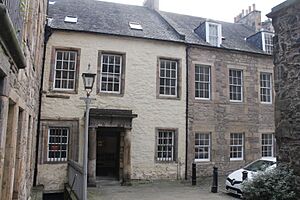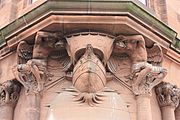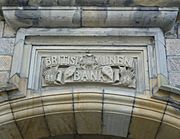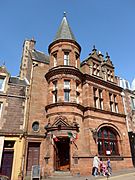British Linen Bank facts for kids
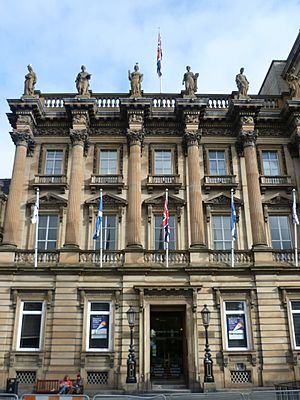
The bank's former head office on St Andrew Square, Edinburgh.
|
|
|
Formerly
|
|
|---|---|
|
|
| Founded | 5 July 1746 |
| Headquarters | The Mound, , |
| Parent |
|
The British Linen Bank was a bank that started in Scotland. It was a special kind of bank called a commercial bank, which helps businesses and people with money. Later, it became part of the Bank of Scotland in 1969. For many years, it worked as the Bank of Scotland's merchant bank, helping businesses with big financial deals.
Contents
History of the British Linen Bank
How the Bank Started
The British Linen Bank began in Edinburgh, Scotland, in 1746. Its first name was the British Linen Company. As the name suggests, it started by focusing on the Scottish linen industry. Linen is a strong fabric made from flax plants.
A man named Andrew Fletcher, Lord Milton, had the idea for this company. He was a lawyer and a very important person in Scottish politics at the time. He wanted to create a big company to make and sell linen across the country.
Two young linen makers, Ebenezer McCulloch and William Tod, helped make this idea happen. They became the first managers of the new company. At its peak in the 1750s, it was one of the largest businesses in Scotland. It handled every step of making linen cloth and employed thousands of people.
To get started, the company needed a special permission from the King. This was called a royal charter. It was granted by King George II on July 6, 1746. The company's first office was in a large house on Tweedale Court in Edinburgh.
From Linen to Banking
When the company got its royal charter, it also received a hidden power: the right to act like a bank. At first, this seemed like a small detail. But the managers, McCulloch and Tod, soon started offering banking services.
- In 1747, they began giving out promissory notes. These were like promises to pay money later.
- By 1750, they were issuing real bank notes, which were like paper money that could be used right away.
Even with these banking services, the company mostly focused on making linen in the 1750s. But it wasn't making much money from linen. There were disagreements about whether to stop making linen and just focus on financing other producers.
By the 1760s, the British Linen Company slowly started to change from a linen maker to a financial company. It gradually reduced its work in the linen industry. The full change from linen to banking wasn't complete until the mid-1770s.
For many years, there was some doubt about whether the company was truly allowed to be a bank. Other banks, like the Royal Bank of Scotland, were worried about the competition. The British Linen Company tried many times to get a new, clearer royal charter for banking. They finally succeeded in 1813. However, they were still not allowed to call themselves the British Linen Bank until 1906.
Growing the Bank
As the British Linen Company became more of a bank, it used its old linen offices to open new bank branches. By 1785, it had a proper system for its bank branches.
By 1800, the bank had 18 branches. It added 25 more in the first half of the 1800s. The bank grew even faster in the second half of that century, opening over 70 new branches.
The British Linen Bank usually didn't buy other banks. There was one exception in 1837 when it bought the Paisley Banking Company, which had three branches. In 1849, Queen Victoria gave the bank a fourth charter, allowing it to have more money to lend. By 1901, the British Linen Bank had one of the largest branch networks in Scotland.
Joining Other Banks
By the early 1900s, the British Linen Bank realized it needed to team up with a larger bank that had international connections. In 1919, Barclays, a big bank from England, bought the British Linen Bank. Even though Barclays owned it, the British Linen Bank kept its own name and mostly ran its business as before. Between World War I and World War II, the bank opened over 40 new branches, giving it more than 170 branches in Scotland by 1939.
In 1969, Barclays sold the British Linen Bank to the Bank of Scotland.
Becoming a Merchant Bank
The British Linen Bank officially joined the Bank of Scotland in 1970. Their offices were quickly combined. For example, the British Linen Bank's main office in Glasgow was taken down to build a new Bank of Scotland office.
However, the law allowed the British Linen Bank to continue as a separate company. So, in 1977, it started working again, but this time as the merchant bank part of the Bank of Scotland. A merchant bank helps large companies with things like buying other companies or raising money.
In 1999, the Bank of Scotland decided to stop using the British Linen Bank name. Its merchant banking services were renamed. The British Linen Bank's headquarters closed its doors for good in April 2000.
British Linen Advisers
In 2000, a new company called British Linen Advisers was formed. It took over the corporate finance work from the Bank of Scotland. This company was run by an independent group of business people. British Linen Advisers closed in Edinburgh in 2008.
Gallery
-
The name of the bank above the entrance to its branch in Falkland, Fife.


